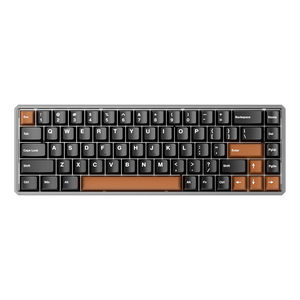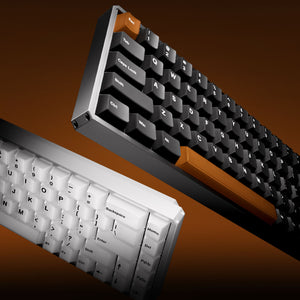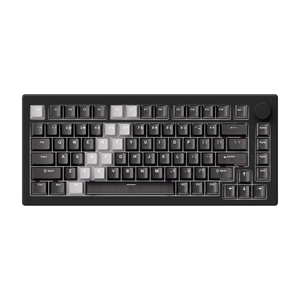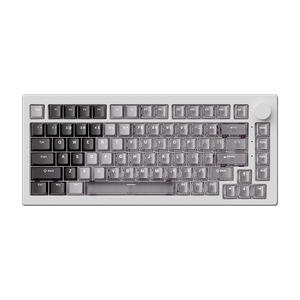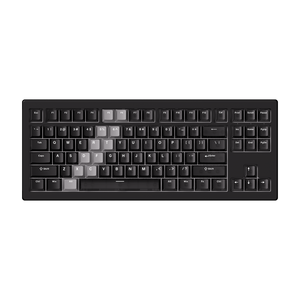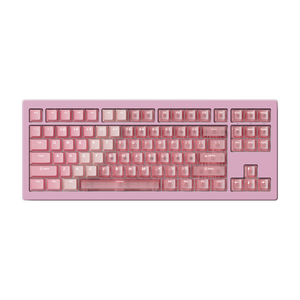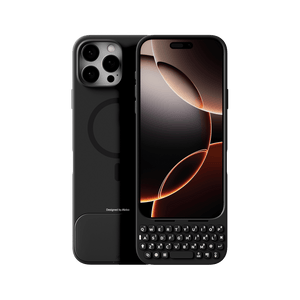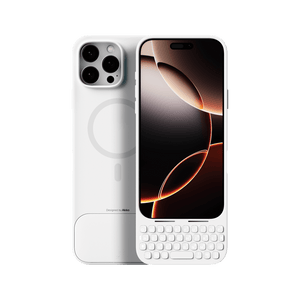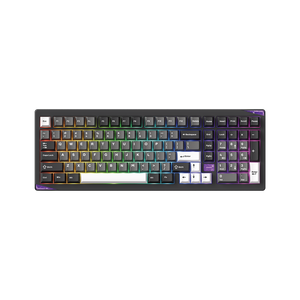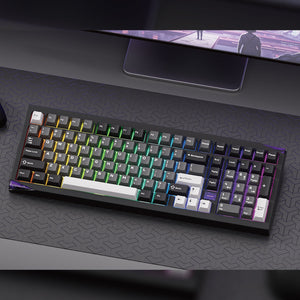What is a low-profile keyboard?
A low-profile keyboard is a special type of mechanical keyboard. The main difference from a conventional mechanical keyboard is the switch height and key travel. The switches on a low-profile keyboard are shorter, making the entire keyboard flatter. This offers unique advantages in terms of typing feel, noise reduction, and portability.
Low-profile keyboard vs. regular mechanical keyboard
The most noticeable difference between a low-profile keyboard and a regular mechanical keyboard is the height. Low-profile keyboards are significantly flatter than conventional models due to shorter keycaps, switches, and casing.
| feature | Low-profile keyboards | Normal mechanical keyboards |
| Switch height & key travel | Shorter switches (1.0–1.5 mm actuation), faster keystrokes | Full switch height (2.0–4.0 mm actuation), deeper key travel |
| Typing feel | Crisper, fast response, flatter typing feel | More tactile, “thocky” feeling with deeper attacks |
| ergonomics | More ergonomic due to thin design, less wrist strain | Bulkier, may require wrist support for extended typing |
| Portability & Design | Slim, compact, lightweight, easy to carry | Bigger, heavier, less portable, but more robust |
| Customization options | Limited switch and keycap customization | Wide selection of switch types, keycap profiles and modifications |
1. Switch height & key travel
Low-profile switches are about one-third the height of standard mechanical switches . While a standard mechanical switch is typically about 18.5 mm tall, a low-profile switch is only 11.9 mm tall.
The shorter switches reduce the key travel, resulting in faster keystrokes and a flatter typing feel.

2. Typing feel
As mentioned above, low-profile switches have shorter actuation points, allowing the keyboard to respond more quickly. Regular mechanical keyboards, on the other hand, offer a more pronounced, "tocky" typing feel.
3. Ergonomics
Low-profile keyboards, with their thinner design, allow your hands to rest more naturally on the keys. This design reduces wrist strain and provides greater comfort and ergonomics. Regular mechanical keyboards typically require a wrist rest to increase comfort.
4. Portability & Design
Compared to a standard mechanical keyboard, a low-profile keyboard is typically more compact and lightweight. Users can easily store it in a bag or take it with them while traveling without sacrificing performance or comfort. However, it can't quite match a membrane keyboard in terms of portability.
5. Customization options
Low-profile keyboards have a limited selection of switch types and keycaps. If you're looking for a high degree of customization, a low-profile keyboard may not meet your needs. Regular mechanical keyboards, on the other hand, offer a wide variety of switch types and keycaps for customization.

Advantages of low-profile keyboards
1. Moderate height, ergonomic
Low-profile keyboards are lower than traditional mechanical keyboards. This makes them more ergonomic, as your wrists don't have to be raised as much. If you spend long hours at your desk, low-profile keyboards are a good choice, as they reduce the risk of wrist pain.
2. Short key travel, faster typing
Low-profile keyboards have a shorter key travel, both in terms of pre-travel and total keystroke travel. This allows for faster key presses and makes typing more efficient.
A low-profile keyboard is particularly suitable if you're used to light and flat laptop or office membrane keyboards. Gamers who want to achieve particularly low input latency by reducing key travel also benefit from this design.
3. Portable and lightweight
Thanks to their lightweight design, low-profile keyboards are ideal for traveling. Their thin overall thickness means they fit easily into a bag without taking up much space—perfect for travelers.
Disadvantages of low-profile keyboards
-
Relatively small selection
Compared to traditional mechanical keyboards, the number of low-profile keyboards available on the market is relatively small. Generally speaking, the product selection for regular mechanical keyboards is almost ten times larger than for low-profile keyboards. -
Fewer customization options
Low-profile keyboards offer fewer customization options than traditional mechanical keyboards. While mechanical keyboards offer a wide range of different switches and keycaps, the options for low-profile keyboards are very limited.

Do I need a low-profile keyboard?
Whether you need a low-profile keyboard depends largely on your personal preferences and usage habits.
Recommendations:
-
For gamers:
If you're a gamer and want faster keystrokes, we recommend choosing a low-profile keyboard. These typically offer shorter key travel, resulting in faster response times.
However, a low-profile keyboard isn't the only solution for faster activation. You can also consider a Hall-effect keyboard , as these offer a rapid trigger function and dynamic keystrokes , which also result in extremely fast response times. -
For on the go:
If you need to transport your keyboard frequently, for example, to work or while traveling, a low-profile keyboard is also a good choice. It's compact, lightweight, and space-saving, making it easier to transport.
Not recommended:
-
If you want to try out different keycaps and switches , a low-profile keyboard isn't the right choice for you. A traditional mechanical keyboard offers you significantly more choice and customization freedom.
-
If you prefer tactile feedback or longer key travel , a traditional mechanical keyboard is also a better choice. These offer a more immersive typing experience and more mechanical feedback, which many users appreciate.
How do I choose a low-profile keyboard?
If you're looking to buy a low-profile keyboard, here are some tips to help you choose.
1. Choose the right switch
There are different types of low-profile switches, similar to traditional mechanical switches. Each low-profile switch offers a different typing feel and noise levels. It's advisable to try the switch before purchasing or read customer reviews to make the best choice.

2. Choose the right size according to your needs
If you're primarily a gamer, a keyboard with a 60% or 65% layout might be more suitable. This compact size offers more room for mouse movement, which is especially beneficial in fast-paced, responsive games. Additionally, smaller keyboards are easier to transport and take up less space on your desk.
3. Pay attention to high workmanship quality
A high-quality low-profile keyboard ensures a longer lifespan. Unlike regular mechanical keyboards, replacing switches and keycaps on low-profile keyboards can be difficult and costly. Therefore, it's best to opt for high-quality products to avoid future problems.
4. Note other important functions
Also look for additional features that meet your needs, such as:
- Wireless connectivity options (Bluetooth, 2.4G)
- Programmability of the keys
- RGB lighting effects
-
Ergonomic design
These features can significantly improve your typing experience or gaming setup.
Conclusion
Low-profile keyboards are characterized by their compact, lightweight, and ergonomic design. They're particularly well-suited for gamers, fast typists, and people who are on the go or have limited desk space. However, the customization options regarding switches and keycaps are more limited than with traditional mechanical keyboards. Whether you choose a low-profile or a standard mechanical keyboard ultimately depends on your personal preferences, intended use, and desired features.
FAQ
Can I use regular keycaps on low-profile switches?
No, regular keycaps will not fit low-profile switches because they have shorter stems and require custom-made low-profile keycaps.
Can I type faster with a low-profile keyboard?
Yes, you can potentially type faster with a low-profile keyboard. Due to the shorter key travel and faster actuation time, inputs can be registered more quickly, increasing your typing speed.
Is a low-profile keyboard good for programming?
Yes, a low-profile keyboard can be great for programming, especially if speed and comfort are important to you. However, it may take a bit of adjustment if you've previously used a traditional mechanical keyboard.
Is a low-profile keyboard good for gaming?
Yes, low-profile keyboards are very suitable for gaming. Because the key travel is shorter, actions can be executed more quickly, which can give you an advantage in fast-action games. The shorter response time allows for more precise and faster in-game commands.


